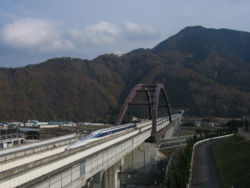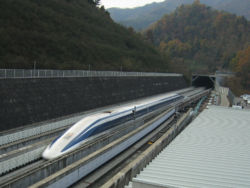JR-Maglev

JR-Maglev, MLX01 (X means experimental), is a magnetic levitation train system developed by the Japan Railway Technical Research Institute (association of Japan Railway Group), composed of a maximum 5 cars to run on the Yamanashi Maglev Test Line. On December 2, 2003, a three-car train set attained a maximum speed of 581 km/h (361 mph) (world speed record for maglev trains) in a manned vehicle run. It is one of the latest designs of a series of Maglev trains in development in Japan since the 1970s.
Contents
Fundamental technology elements
 Levitation System |
 Guide System |
 Drive System | |
- See also: technology in the magnetic levitation train article.
Magnetic levitation trains make use of a levitation system, a guide system, and a driving system.
Levitation
The JR-Maglev levitation train uses an Electro-dynamic Suspension (EDS) system. Moving magnetic fields create a reactive force in a conductor because of the magnetic field effect. This force holds up the train. The maglev-trains have superconducting magnetic coils, and the guide ways contain levitation coils.
When the trains run at high speed, levitation coils on the guide way produce reactive forces in response to the approach of the superconducting magnetic coils onboard the trains.
EDS has the advantage of larger gaps than EMS, but EDS needs support wheels which are employed in low speed running, because EDS can't produce a large levitation force at low(er) speeds (150km/h or less in JR-Maglev). However, once the train reaches a certain speed, the wheels will actually retract so that the train is floating.
Guide
Levitation coils which are located on the guide way generate guiding and stabilizing forces also.
Driving
JR-Maglev is driven by a Linear Synchronous Motor (LSM) System. This system is needed to supply power to the coils at the guide way.
Experimental lines in Yamanashi Prefecture

Yamanashi Experiment Lines are facilities that currently have a practical use. It includes about 18.4km of rail (including 16.0km of tunnels).
History
- 1962 – Initial technology research was started.
- 1977 – Miyazaki Prefecture began applying the technology to rail transport.
- 1979 – Experimental ML500 train reached a speed of 517 km/h (with no passengers).
- 1987 – Reached a speed of 400.8 km/h with passengers.
- 1997 – The experiment run was started at Yamanachi tracks (MLX01) on April. In December, it reached a speed of 531 km/h with passengers.
- 2003 – Reached a speed of 581 km/h with passengers.
- 2004 – Number of passengers for Maglev trial ride exceeded 80,000 persons. Test of two trains passing each other at a maximum relative speed of 1,026 km/h.
- 2005 - Crown Prince Naruhito experienced Maglev trial ride.
See also
| Wikimedia Commons has media related to: JR-Maglev |
- Aérotrain
- Chūō Shinkansen
- High-speed rail
- Land speed record for railed vehicles
- Magnetic levitation train
- Transrapid
Further reading
- Hood, Christopher P. (2006). Shinkansen – From Bullet Train to Symbol of Modern Japan. Routledge. ISBN 0-415-32052-6.
External links
- Yamanashi Linear Express Fan Club (in Japanese)
- A site with MLX01 video and photo (in Japanese)
- MLX01 Video
- Another MLX01 video
- Internat. Maglev Board
- Railway Technical Research Institute (RTRI)
- RTRI Maglev Systems Development Department
- Central Japan Railway Company
- Central Japan Railway Company - Chuo Shinkansen
- Central Japan Railway Company - Superconducting Maglev
- Central Japan Railway Company - Linear Express
- Linear Chuo Express (in Japanese)
- Linear Chuo Express for kids website (in Japanese)
- Linear Chuo Shinkansen Project
| High-speed trains | |
|---|---|
| Acela Express • Alfa Pendular • AVE • ETR 500 • Eurostar • InterCityExpress • JR-Maglev MLX01 • HST • Korea Train Express • Magnetic levitation trains • Pendolino • Shinkansen • TGV • Thalys • THSR • Transrapid • Treno Alta Velocità • X 2000 |
de:JR-Maglev id:JR-Maglev ja:ジェイアール式マグレブ pt:JR-Maglev ru:JR-Maglev

